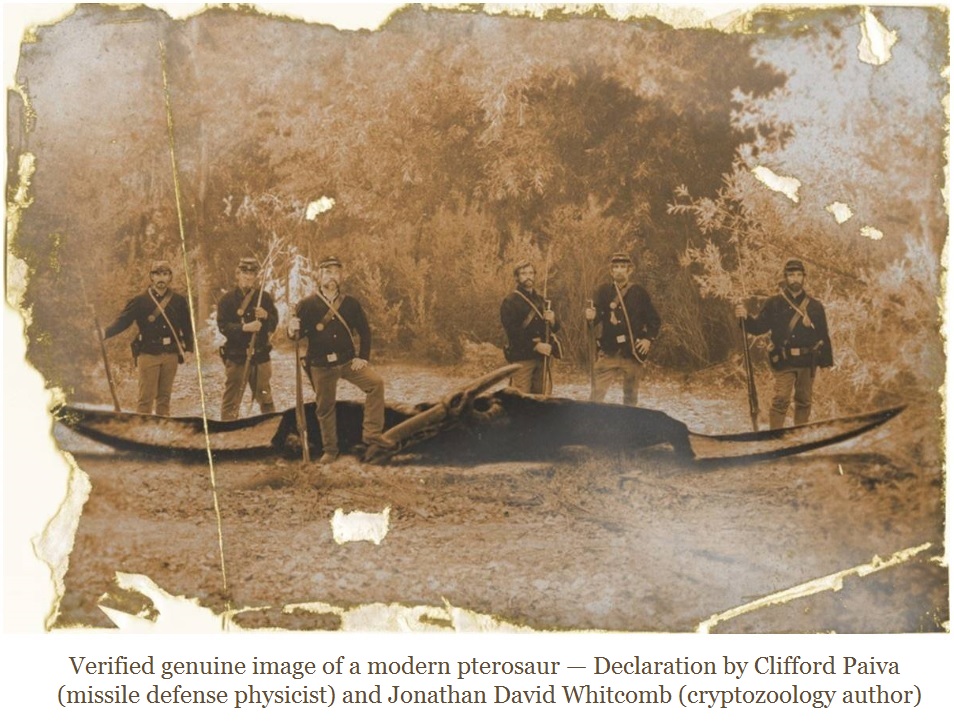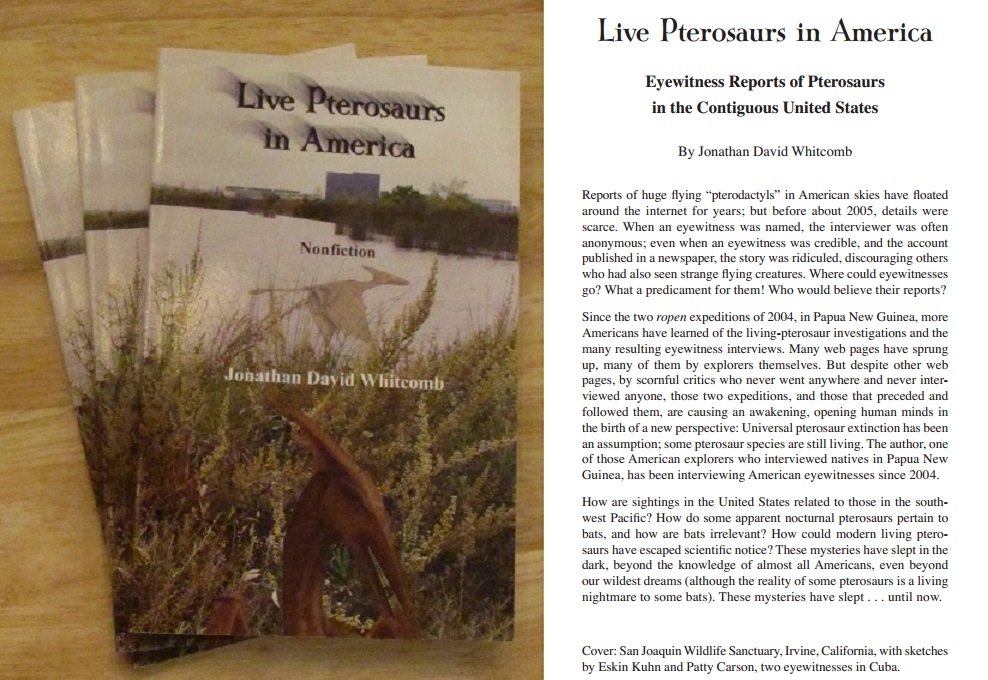By the modern pterosaur expert Jonathan David Whitcomb
Why did it take me so many years to recognize the validity of the old photograph that we now call “Ptp?” I’ve been investigating eyewitness reports of apparent extant pterosaurs since 2003, spending well over 10,000 hours on my investigation, which now approaches 14 years of work. I’ve known of this photo for a long time, having first seen it in an old book, possibly as early as 1968, to the best of my memory.
But not until January 14, 2017, did I give the image my full support as valid evidence for a modern pterosaur. That’s when I talked with the physicist Clifford Paiva by phone, and we agreed that the photo has a valid image of a real animal. We stopped short of insisting it must be a species of Pteranodon; neither of us is a paleontologist. But the resemblance of its head to that of a Pteranodon is obvious.
Why Did it Take so Long to Recognize?
Be aware that Paiva recognized the importance of this photo many years ago, and I wrote about the possibility of its authenticity in several blog posts in 2013. He deserves the credit for his early examination and recognition of Ptp, and I finally see it for what it is, so I might not be the slowest fool who has ever lived on this planet, maybe not the slowest.
But since I have the biggest mouth, of all humans who have ever lived, on the subject of modern pterosaurs, what happened? A brief online search with something like “living pterosaurs” could give one the impression that I’ve written more on this subject, of sightings of apparent pterosaurs, than everybody else in the world combined, at least when viewing the first few page-results from a Google search. Why was I so slow?
Before viewing Ptp, be aware that another photo has been orchestrated to promote a TV show, and that imitation, a hoax-photo from Civil-War reenactors, has caused confusion. The fake-photo was created around the year 2000 to promote the Freakylinks series (produced by Haxan Films) which was on the Fox Network. You can recognize the hoax photo in several ways, one being the “soldier” on the far left, who is heavyset, with his shirt mostly unbuttoned.
Rather than dwell on that, however, let’s examine the original (Ptp) photograph:
Figure-1: Ptp photograph declared authentic (click to see both photos for comparison)
.
“Canoe” Appearance of Wings
Some persons, when they first see this photo, get the impression that the wings are actually one or two canoes, put together to make a model of a giant “pterodactyl.” I was one of those who made that mistake many years ago. But early in January of 2017, I got an email from a Tom Paine, who told me this:
I’ve canoed all my life. I’ve owned several of them. Those aren’t halves of a canoe! . . . Too narrow, too shallow. And definitely not a dugout canoe!
Well, of course it’s obviously not ends of one or two canoes, after you look closely and carefully. Even if an adult could fit into a canoe of that size, it would not stay afloat for more than a couple of seconds or so. In other words, those apparent wings are not the ends of canoes.
Where’s the Background Story?
That canoe blunder was only the first stumbling block for me. In more recent years, I’ve wondered this: How could an authentic photograph of a modern pterosaur not be attached to a newspaper story that was passed down through the generations, resulting in some degree of official recognition of the photograph? That was part of what kept me from looking more closely at Ptp many years ago.
In recent weeks, I’ve seen the other side of the street: How could an extremely elaborate hoax photo not be claimed by the person or persons responsible, after so many years? Some persons remember it from the mid-20th century, long before Photoshop existed. If Ptp were a hoax photo, it was apparently put together decades ago, and what a project it would have been! A model created to look so much like a Pteranodon—that would have taken a lot of work. Somebody should have taken credit for it by now, if it were a hoax.
But let’s get back to my second stumbling block: Where’s the newspaper story of a huge flying “monster” that was photographed in the mid-19th century? I don’t know of any such newspaper article. That does not mean no such story was ever printed, of course. Yet there’s an explanation for why such a story did not become well known.
Put the case that a photographer, during the Civil War, captured the image we see, the photo now called “Ptp.” Would it not have been labeled an “unknown bird” or “monster?” Almost nobody had any knowledge, at that time, of what a non-fossilized Pteranodon would have looked like, even if they knew of that name. Sketches were published in the early 20th century, of that type of pterosaur, but those images were preliminary, with little knowledge even at that later time.
So what would a newspaper editor, in the 1860’s, do with a photograph that looked like it had a weird elongated head of some creature connected to two apparent ends of a canoe? Give it back to the photographer. The most interesting part of the story would have been in the photograph itself, and newspapers did not print photographs at that time. In addition, if this was during the Civil War, how many exciting and important battle stories would that editor have to publish!
The point is this: An American newspaper editor in the 1860’s would not likely realize that this was a photograph of a creature that was supposed to have become extinct long ago. And even if one editor was bright enough and informed enough to recognize that possibility, an older editor-in-chief would have shot down his suggestion that the story be published. Who cares about a weird unidentified bird? After all, we have a war to cover.
Why was it not Officially Recognized Sooner?
My third stumbling block probably has tripped up other persons as well. If Ptp is an authentic photograph of a modern pterosaur, why has it not been recognized before the 21st century, with newspaper headlines and many scientific papers being published about it in journals of science in the 20th century? Good question.
A good answer could require a book-length examination. Here, at the end of a blog post, we’ll have to be brief. Deep indoctrination into universal extinctions of basic types of life—that has made objective evaluation of evidence for extant pterosaurs extremely rare in Western societies. Who wants to rock the boat, even if the canoe conjecture cannot stay afloat? It’s much easier to proclaim “Photoshop” and turn away from the photo. At least a professor will then have a good chance to hold onto his respected position at a university.
In reality, scientists who are willing to examine Ptp and proclaim its authenticity are more rare than the largest of extant pterosaurs that fly overhead at night. Skeptics have been accumulating weapons for over a century, ready to be aimed and fired at anyone who proclaims they have evidence that looks threatening to old dogmas about universal extinctions. Few of us are willing to stand up and speak out, knowing of the imminent barrage that will be coming our way.
###
Copyright 2017 Jonathan Whitcomb
.
Was a Pterodactyl Shot During the American Civil War?
Much confusion has come from publicity involving two photographs that, on the surface, greatly resemble each other. The following shows them side by side for comparison
Modern Pterosaur in a Civil War Photograph
Notice that the important subjects of the photo, the strange winged animal and the soldiers—all of them are in reasonably good focus, a characteristic of Civil War photography.
The popular textbook declaration that all species became extinct millions of years ago, universal pterosaur extinction—that concept itself is approaching extinction.
.
*************************************************************************************************************************
Third edition of the nonfiction cryptozoology book Live Pterosaurs in America
.



